
Residential Grid Tied Wind Turbine
IamSmooth, Sat Jun 20 2009, 07:34PMI have not had an electric bill for two years due to the solar array I installed on my roof. I wanted to do more, so I figured a wind turbine would be a nice addition. However, I wanted to do it myself, and not purchase a pre-made system.
I initially started with a F&P system by re-enginneering the Fisher & Paykel washing motor with neo magnets. My tail boom was too thin, and it snapped in some high winds and it destroyed my first turbine blades and assembly. I followed through with an axial flux design.
The axial flux design has the magnetics on two spinning rotors. The flux is contained between each magnet pair and the iron disk that supports them. The stator is a three phase disc that rests between them.
I did everything myself, except build the inverter. I got some help on this board for building the shunt controller, and I am very thankful for it, especially for the time Neil gave me.
I kept a very detailed photo log on a website and the project can be viewed from start to finish here. Here you will find an index that can take you to various sections. I start with my Fisher&Paykel system. After its destruction, I continue with the axial system. The project consists of many parts and disciplines. They are:
Mechanical/construction: tower analysis & construction, winch design
Welding skills
Woodworking, Blade carving/shaping/balancing, airfoil analysis
Metalworking and lathe working
Electrical engineering: stator/rotor design to match power from blades
Electrical engineering: shunt controller design
Electrical engineering: working with MAINS, interfacing with GRID and Solar inverters
Electrical engineering: lightning protection
Basically, the project consists of building a tower that is easy to raise and lower; building the generator; carving the blades to match the generator; running the power to the grid with the appropriate disconnects and power diversion features. Most people charge batteries with wind energy. This requires a compromise in power output. This is because wind energy goes up with the cube of speed. Low winds have little energy and high winds have enormous energy. One has to determine if they want to harness more consistent lower energy winds, or capture infrequent high energy winds. This is because the stator and blades need to be matched. A stator that can handle high power levels in high winds will stall out the blades in lower winds. If the blades are too large for the stator they will run away in high winds and fry the stator, or cause the turbine to self destruct from high RPM. I chose to feed power to the grid, allowing the inverter to draw off the appropriate amount of power at various wind speeds.
I have the inverter programmed to expect 15% efficiency from the system. Losses are due to limits on wind-power extraction (theoretical maximum is 59%), friction, stator heating, power transmission, and inverter power conversion. I will experiment with various efficiency numbers and see how much power I can squeeze out of the turbine. I am hoping to get 1.5-2kw from 30mph winds. After this the turbine will start to furl out of the wind.
Below are some pictures of the project, but you can see the whole thing at here. The last page of the project is here
This is a 42' tower made from 3"ID steel pipe. The rotor is 10.5' in diameter. The whole assembly weighs close to 100 lbs. Three levels of guy wires hold the tower in place.
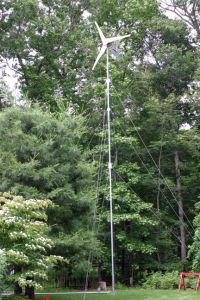
This is a close-up of the rotor and assembly. The blades were made from laminated pine that I carved with a chainsaw. After shaping they were coated with epoxy paint and spayed with acrylic clear coat enamel. The tail furls in high winds.

Here is a close-up of the steel assembly. I did all the welds myself. I did 95% of the cuts. The rotor discs and stator bracket were water-cut.
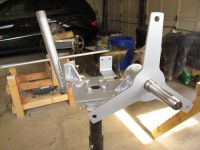
The anchors need to withstand a lot of force. They are buried almost 4'. High strength concrete is poured over 12" brake rotors. The rods are 5/8" galvanized steel.
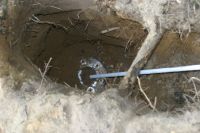
Here is the winch assembly. The pad is 4' deep with rebar and 12" J-bolts for attaching the winch. The winch is rated for 2500 pounds. The 1/4" cable can hold 1400lbs. I also have a lateral support line wrapped around a tree. This is a safety line that takes most of the lateral shearing force. The 4 bolts holding the winch down are enough, though, even without this extra line.
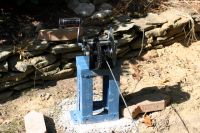
After calculating the profile, I made a jig so I could use a chainsaw to carve the blades. Once the jig is made, I can bang out blade after blade, saving a lot of time carving.
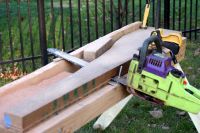
The blades can rotate over 500 RPM so they need to be perfectly balanced.
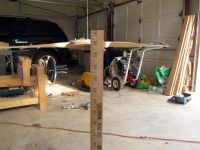
The coils need to be wound tightly with exactly the same turns for the three phase stator.
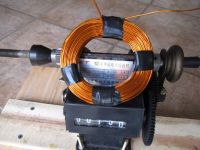
The stator is 3 phase. Each phase has three coils of 110 turns #16 wire. It is cast in fiberglass resin filled with marble dust to help dissipate the heat. ATH was another option, which theoretically would be better, but I don't know if it will make a huge difference. The center of the coils is open to help disperse the heat.
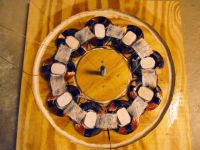
Stator is cast in fiberglass resin, mixed with chopped glass and marble dust.
Magnetic rotor made from 1/4" steel discs and 42N 2"x1/2" neodymium magnets. Each magnet can pull 110 pounds. There are 24 of them.

The shunt controller will divert power to a dump load. This is important to protect the inverter if the grid (load) goes offline, or if the voltage becomes too high for the inverter.
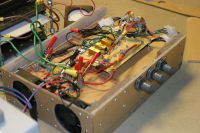
This is part of the MAINS interface. There is an electronic brake that shorts the phases. This keeps the turbine from moving. There is a wind disconnect, inverter/filter box, and shunt controller. Not shown is the DC disconnect, inverter and AC disconnect subpanel.

The power curve for the turbine is programmed into the inverter. This allows maximum power extraction from the wind without stalling the blades by drawing too much power at a given wind speed. When the blades stall the wind no long flows laminarly over the blades. It pulls away and the lift is lost.
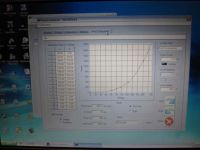
Programming setup is shown.
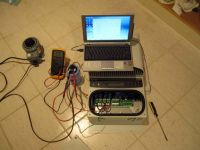
Re: Residential Grid Tied Wind Turbine
Dennis Rogers, Sat Jun 20 2009, 09:55PM
You've put a lot of work into this project. It's awesome to see someone make and design a system from scratch. Great looking work. Update us on how much power you make.
Dennis Rogers, Sat Jun 20 2009, 09:55PM
You've put a lot of work into this project. It's awesome to see someone make and design a system from scratch. Great looking work. Update us on how much power you make.
Re: Residential Grid Tied Wind Turbine
Z28Fistergod, Sun Jun 21 2009, 02:58AM
The whole thing looks fantastic, I am especially impressed with the home made generator. How much time do you have in the whole project? I guess you have some sort of phase matching with the other inverter from your solar cell battery bank? I don't see how using a separate inverter solves the issue of matching the turbine and generator to your average wind speeds. You just as easily could have constructed a charge controller that could provide a variable load to the generator. Either way it does look good.
Z28Fistergod, Sun Jun 21 2009, 02:58AM
The whole thing looks fantastic, I am especially impressed with the home made generator. How much time do you have in the whole project? I guess you have some sort of phase matching with the other inverter from your solar cell battery bank? I don't see how using a separate inverter solves the issue of matching the turbine and generator to your average wind speeds. You just as easily could have constructed a charge controller that could provide a variable load to the generator. Either way it does look good.
Re: Residential Grid Tied Wind Turbine
Finn Hammer, Sun Jun 21 2009, 05:27AM
A toolmaker, jigs and fixtures, myself, I am impressed by your turbine blade carving fixture.
Back in the early 80'es I ran with a group of wind turbine experimentors, and they made one off blades all the time. We never got that jig made, although we talked about it all the time.
Generator and all is very impressive work, but you might want to move the generator out of the way of the trees.
You are smooth indeed!
Cheers, Finn Hammer
Finn Hammer, Sun Jun 21 2009, 05:27AM
A toolmaker, jigs and fixtures, myself, I am impressed by your turbine blade carving fixture.
Back in the early 80'es I ran with a group of wind turbine experimentors, and they made one off blades all the time. We never got that jig made, although we talked about it all the time.
Generator and all is very impressive work, but you might want to move the generator out of the way of the trees.
You are smooth indeed!
Cheers, Finn Hammer
Re: Residential Grid Tied Wind Turbine
IamSmooth, Sun Jun 21 2009, 05:50AM
Moving the turbine above the trees would be ideal, but if I did this the tower could then hit the house if it fell. Right now it would just miss. I trust my cables and anchors, but I like knowing it won't hit.
The inverter does more than vary the load. It synchronizes with the grid just like the solar inverters. In order to be UL listed it must meet very strict requirements. As the wind speed picks up so do the RPM. The higher the RPM the higher the voltage. The inverter increases its load as the voltage increases in order to draw more current.
I put about one year into this working on and off one or two days a week. I did have to go to my day job, after all.
IamSmooth, Sun Jun 21 2009, 05:50AM
Moving the turbine above the trees would be ideal, but if I did this the tower could then hit the house if it fell. Right now it would just miss. I trust my cables and anchors, but I like knowing it won't hit.
The inverter does more than vary the load. It synchronizes with the grid just like the solar inverters. In order to be UL listed it must meet very strict requirements. As the wind speed picks up so do the RPM. The higher the RPM the higher the voltage. The inverter increases its load as the voltage increases in order to draw more current.
I put about one year into this working on and off one or two days a week. I did have to go to my day job, after all.
Re: Residential Grid Tied Wind Turbine
Arcstarter, Sun Jun 21 2009, 05:19PM
Very impressive. I am not into these kinds of things anymore, but this was very interesting. I looked at the whole page you linked and still wanted to read more :P
Arcstarter, Sun Jun 21 2009, 05:19PM
Very impressive. I am not into these kinds of things anymore, but this was very interesting. I looked at the whole page you linked and still wanted to read more :P
Re: Residential Grid Tied Wind Turbine
IamSmooth, Sun Aug 09 2009, 09:55PM
So far the turbine/tower has survived on major storm. It peaked at close to 1.8kw of power. I have made some adjustments. I am hoping to get closer to 3kw before the turbine furls out of the wind.
IamSmooth, Sun Aug 09 2009, 09:55PM
So far the turbine/tower has survived on major storm. It peaked at close to 1.8kw of power. I have made some adjustments. I am hoping to get closer to 3kw before the turbine furls out of the wind.
Re: Residential Grid Tied Wind Turbine
aonomus, Sun Aug 09 2009, 11:39PM
Very nice build, and congrats on getting off the grid! You are fortunate that your utility company allows feeding back into the grid, which with a good source of wind/solar means you don't have to maintain a costly bank of batteries...
aonomus, Sun Aug 09 2009, 11:39PM
Very nice build, and congrats on getting off the grid! You are fortunate that your utility company allows feeding back into the grid, which with a good source of wind/solar means you don't have to maintain a costly bank of batteries...
Re: Residential Grid Tied Wind Turbine
GhostNull, Sun Jan 24 2010, 11:22PM
And great work Iamsmooth
GhostNull, Sun Jan 24 2010, 11:22PM
IamSmooth wrote ...
Basically, the project consists of building a tower that is easy to raise and lower; building the generator; carving the blades to match the generator; running the power to the grid with the appropriate disconnects and power diversion features. Most people charge batteries with wind energy. This requires a compromise in power output. This is because wind energy goes up with the cube of speed. Low winds have little energy and high winds have enormous energy. One has to determine if they want to harness more consistent lower energy winds, or capture infrequent high energy winds. This is because the stator and blades need to be matched. A stator that can handle high power levels in high winds will stall out the blades in lower winds. If the blades are too large for the stator they will run away in high winds and fry the stator, or cause the turbine to self destruct from high RPM. I chose to feed power to the grid, allowing the inverter to draw off the appropriate amount of power at various wind speeds.
To solve the problem of variable wind speeds you could engineer some kind of automatic transmisson but i don't think that would be very feasable for a hobbist. =SBasically, the project consists of building a tower that is easy to raise and lower; building the generator; carving the blades to match the generator; running the power to the grid with the appropriate disconnects and power diversion features. Most people charge batteries with wind energy. This requires a compromise in power output. This is because wind energy goes up with the cube of speed. Low winds have little energy and high winds have enormous energy. One has to determine if they want to harness more consistent lower energy winds, or capture infrequent high energy winds. This is because the stator and blades need to be matched. A stator that can handle high power levels in high winds will stall out the blades in lower winds. If the blades are too large for the stator they will run away in high winds and fry the stator, or cause the turbine to self destruct from high RPM. I chose to feed power to the grid, allowing the inverter to draw off the appropriate amount of power at various wind speeds.
And great work Iamsmooth
Re: Residential Grid Tied Wind Turbine
aonomus, Mon Jan 25 2010, 05:52AM
I believe he has a grid tied inverter that also doubles as a maximum power point tracking (MPPT) controller. Essentially a buck-boost converter that controls its current draw from the source to maximize its net power output (ie: too much draw and it stalls, to little and you waste power). The MPPT would also buck-boost to grid voltage, negating the transmission issue.
aonomus, Mon Jan 25 2010, 05:52AM
I believe he has a grid tied inverter that also doubles as a maximum power point tracking (MPPT) controller. Essentially a buck-boost converter that controls its current draw from the source to maximize its net power output (ie: too much draw and it stalls, to little and you waste power). The MPPT would also buck-boost to grid voltage, negating the transmission issue.
Re: Residential Grid Tied Wind Turbine
cduma, Mon Jan 25 2010, 07:35PM
I started designing a similar system awhile ago and had problems securing the magnets to the rotor. How were you able to secure them and avoid smacking them together?
cduma, Mon Jan 25 2010, 07:35PM
I started designing a similar system awhile ago and had problems securing the magnets to the rotor. How were you able to secure them and avoid smacking them together?
Re: Residential Grid Tied Wind Turbine
cduma, Wed Jan 27 2010, 09:01PM
Is the chance for complete failure low? With this type of project it will work at least a little bit right? What shape of magnet will work best and which will work the worst aside from spheres?
cduma, Wed Jan 27 2010, 09:01PM
Is the chance for complete failure low? With this type of project it will work at least a little bit right? What shape of magnet will work best and which will work the worst aside from spheres?
Re: Residential Grid Tied Wind Turbine
TheMerovingian, Tue Mar 02 2010, 11:33PM
What kind of bearing you use for both the alternator and wind chasing?
TheMerovingian, Tue Mar 02 2010, 11:33PM
What kind of bearing you use for both the alternator and wind chasing?
Re: Residential Grid Tied Wind Turbine
haxor5354, Tue Mar 30 2010, 01:35AM
so your house runs on a bank of batteries? do u use modified-sine wave inverters or pure sinewave inverters
haxor5354, Tue Mar 30 2010, 01:35AM
so your house runs on a bank of batteries? do u use modified-sine wave inverters or pure sinewave inverters
Re: Residential Grid Tied Wind Turbine
marchse, Thu Jul 01 2010, 04:40AM
Ofcourse he would have used the inverters for the DC to Ac conversion..
Power Plant Development
marchse, Thu Jul 01 2010, 04:40AM
Ofcourse he would have used the inverters for the DC to Ac conversion..
Power Plant Development
Re: Residential Grid Tied Wind Turbine
lpfthings, Thu Jul 01 2010, 08:40AM
He would have had to have used a pure sinewave inverter, especially if he is feeding back into the grids. Transformers don't really like modified sine waves, not to mention induction motors.
lpfthings, Thu Jul 01 2010, 08:40AM
He would have had to have used a pure sinewave inverter, especially if he is feeding back into the grids. Transformers don't really like modified sine waves, not to mention induction motors.
Re: Residential Grid Tied Wind Turbine
Matt Edwards, Sat Jul 03 2010, 02:33AM
I am sure that you have hear this already but... dude, "Beautiful"! Amazing job!
Matt Edwards, Sat Jul 03 2010, 02:33AM
I am sure that you have hear this already but... dude, "Beautiful"! Amazing job!
Re: Residential Grid Tied Wind Turbine
Adam Munich, Wed Nov 03 2010, 05:37AM
Just a few questions...
How many watts did you actually get from this thing?
How much did it cost?
How many watts do you get from your solar array?
How much did that cost?
Was it worth it and have the lack of bills paid it off yet?
How many Ah's does your battery store, and at what voltage?
Lead acid or other?
I ask these Qs because somday I'd like to be off the grid too.
Adam Munich, Wed Nov 03 2010, 05:37AM
Just a few questions...
How many watts did you actually get from this thing?
How much did it cost?
How many watts do you get from your solar array?
How much did that cost?
Was it worth it and have the lack of bills paid it off yet?
How many Ah's does your battery store, and at what voltage?
Lead acid or other?
I ask these Qs because somday I'd like to be off the grid too.
Print this page